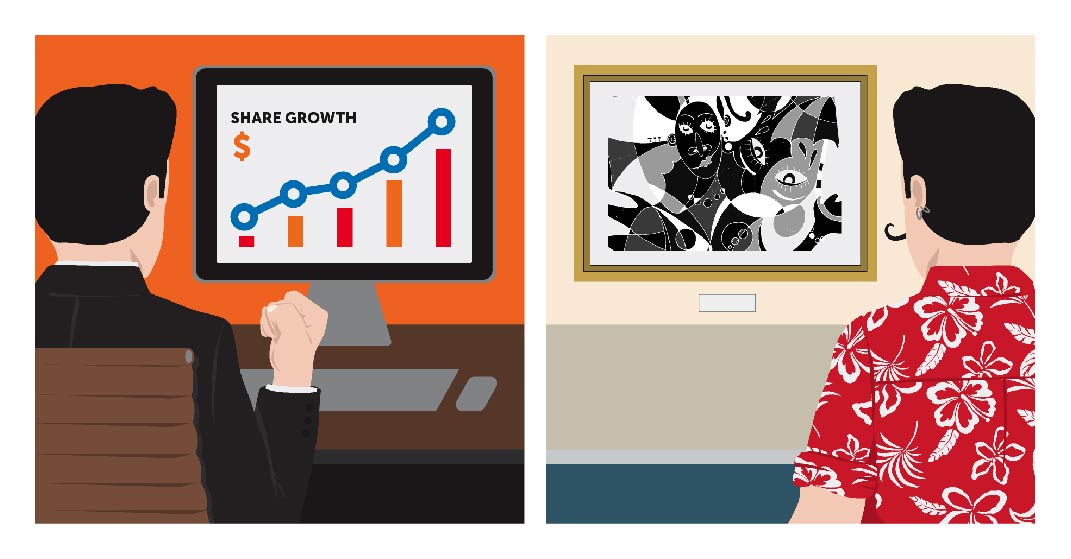
“If you want something new, you have to stop doing something old” – Peter Drucker
Lisbon. An employee of Portugal’s main bank admits that he only processed two loan applications from cultural and creative industries (CCI) sector for the entire year 2018.
Prague. Our capacity building seminar to explain how the cinema industry works to the bank’s employees is well underway. As I describe another version of the film industry’s value chain an employee asks: “What is VOD”? So it goes.
It has now been a year since we began working for the European Investment Fund (EIF) as a consortium partner in the implementation of a capacity building scheme aimed at reinforcing the abilities of banks to lend to cultural and creative sectors (CCS). The core mission of the EIF is to support the development of small and medium-sized companies in Europe by helping the latter to access funding.
This article describes the immersion of KEA in a new environment: the world of financial institutions. Its goal is to help mobilise the CCS to benefit from the EU guarantee facility. In one year KEA entered deep enough into the project’s machinery to propose a first assessment and share some lessons. This article aims to alert cultural and creative entrepreneurs to the opportunity of a dialogue with the financial community. This year led us to discover the difficulty of talking about the cultural economy outside of the cultural environment, as well as establish the clear and frightening lack of interaction between cultural enterprise and banks, whether public or private.

The European CCS is internationally competitive, a great provider of wealth and employment. It is taking advantage of the explosion in demand for cultural content in streaming and on mobile platforms (smartphones), notably in music, video games, or audiovisual productions. The sector has its international champions (e.g. Universal, Dior, Ubisoft, BBC, Gucci, Supercell). Furthermore, it is made of a myriad of agile and creative structures managed by passionate and competent entrepreneurs, often leaders in their country. Despite their success, entrepreneurs in the creative field often suffer from chronic underfunding and lack of interest from banks.
The relations between the financial sector and the world of culture are difficult. They are characterised by profound mistrust, fuelled by clichés of sectors that ignore each other at best or despise each other at worst. The cultural sector believes that seeking bank financing is a waste of time. The banking sector is unwilling to commit to a sector that it finds difficult to grasp. The capacity building programme for banks is the opportunity to question mutual stereotypes and prejudices by enabling exchanges between the two worlds and consider a “win-win” collaboration.
The European Commission estimates the funding gap for the CCS sector at 8 billion euros. In 2016, it decided to establish a fund to guarantee loans granted by the banks participating in the programme. To this day, we expect a dozen participating banks in ten EU countries (Belgium, Denmark, Spain, France, Italy, the Netherlands, Poland, Portugal, Romania, the Czech Republic [1])
This financial facility is the most remarkable public policy measure ever adopted at European level to promote the competitiveness of the creative economy, provider of 8 million jobs in Europe [2], expressing the diversity of the continent’s local cultures and its incredible creative capacity.
The bet is made that banks’ appetite for CCS will be increased by focusing the capacity building scheme to assist banks in analysing risks associated to a loan request from the various actors in the value chain of the CCS subsectors [3]. This perspective requires the implementation of a training programme dedicated to risk analysis. Experience shows that it is difficult to summarise in a simple diagram the operating mode of an industry of prototypes subject to local constraints (legal, aid, degree of concentration, languages) and specific entrepreneurial motivations. Due to lack of time it risks transforming workshops in non-interactive technical lectures. In addition while the quest for notoriety or artistic respectability in this industry is as important as the pursuit of profit, it is also almost impossible to reassure the analyst in a context of collaterals that are often intangible.
The situation could be likened to a travel agency attempting to sell a trek in the Annapurna to experienced walkers by insisting on the dangerous aspects of the expedition thus emphasising the weather risks, the steepness of the climb or the wilderness of the environment. Only the intrepid would be tempted by such adventure. To be successful the seller would want to highlight the elements of beauty, the encounter of new horizons and positive transformation that the customer will experience by walking on the roof of the world. The positive potential of the activity is more likely to win over buyers than stressing risk elements.

It is obvious that companies of the CCS must make the effort to adapt their language to meet banks’ requirements (reimbursement prospects) and adapt to the risk analysis. However, the decision to lend to CCS comes foremost from a strategic decision. The participation of banks in the capacity building programme reflects this strategic commitment. The ability to support and implement such a commitment ultimately depends on the capacity of the banks’ employees to understand and identify opportunities in the sector and the ability to seduce a new clientele of entrepreneurs seeking loans.
Is the sector capable of being seduced? Is it presenting itself in its best light to potential investors?
The sector’s assets are substantial [4]. This fast-growing sector is carried primarily by the investment of “big techs” (Netflix, Apple, Amazon, Google, Tencent, Comcast, Spotify) concerned with developing services on their globalised “streaming” networks and platforms and in constant search for localised content. Secondly, it concentrates the industries of tomorrow able to satisfy this demand for beauty, leisure, design, comfort, meaning or memory and expressions of local culture.
In a collaborative mode, the CCS finds itself often parachuted amongst the creative hubs and audio-visual clusters populating urban ecosystems, in partnership with local public authorities eager to promote its emergence in order to increase territorial attractiveness. The potential for exportation is evident notably in South East Asia where manufacturers are looking for European creators to develop the local creative industries – for example in furnishing, clothing or household tools. The same is true for expanding cities in developing countries in needs to develop their cultural offer to attract talents.
Cultural and creative industries originate from the European territory. Its cultural industries are the most developed in the world and the creative ability of our continent is envied. This creative Europe already attracts half of global tourism, mainly thanks to its heritage and cultural offer. Despite this undeniable assets CCS ‘contribution and influence remain largely unnoticed. Start-ups in the sector fail to generate the same enthusiasm amongst investors as in the related digital industries.

The capacity building programme aims to increase awareness of banks to as post-industrial society in which CCS is a main driver. It shows the role and impact of cultural entrepreneurs in economic growth, social developments or competitive disruptions of which they are often the originator; the best example is Apple where success centred on the ability of Steve Jobs to combine culture (design, art, music, apps) and technology. The training programme is also the opportunity to emphasise the essential contribution of cultural entrepreneurs and workers in the development of the experience, sustainable, networked and sharing economy.
The generation of loans to the sector will be a direct consequence of the ability of bank employees to understand the intrinsic value of creativity as an economic and social innovation tool. The CCS has to rethink its discourse (often only audible to culture specialists) to make it relevant to wider economic and social issues. This will help increase understanding on the impact of cultural investment to regenerate, innovate and develop. The spreading of this narrative should be the role of CCS professional trade associations and Creative Europe offices scattered throughout the continent.
Ultimately, the CCS risk analysis will be no different to risk assessment taking place in the technology sector. Banks will have to surround themselves with CCS specialists, able to understand and interpret the track record and potential of a company in a market that is constantly evolving because of creativity, technological transformations and new consumption trends. A banker cannot be asked to decide on the potential of an artist or a movie. However, he should be able to count on professional expertise to take an informed decision.
The capacity building programme is funded by Creative Europe (DG Connect of the European Commission [5]), the European programme supporting the development of cultural industries. Therefore it would be curious if banks were the only direct beneficiaries of the capacity building programme. It is important that the CCS rallies to promote the submission of loan applications, aiming at increasing their volume and quality with due regards to bankers’ constraints. In addition the relation between bank and cultural entrepreneurs must be addressed pro-actively in order to foster dialogue, fight stereotypes and establish a credibility that will facilitate the review of funding requests. The programme is the opportunity to contribute and influence policies on the funding of cultural industries, as well as the development of financial products and services adapted to the sectors’ characteristics.

Finally, while it is important to encourage banks to fund CCIs, it is also essential to make sure that the capacity building and the funding benefit CCS as a whole. Loans should support the structural development of companies (rather than projects), at both production and distribution levels. CCS professional trade associations must be able to mobilise themselves, as efficiently as film producers’ associations which are currently the most solicited by banks requesting training. The challenge is to rally both at national level, to be able to work with financial intermediaries in the countries, as well as at the European level, to defend the existence and implementation of the financial facility established by the European Commission to support the competitiveness of the CCS.
Philippe Kern
Sources:
[1] The list of the participating banks acting as intermediary in the establishment of the facility in seven countries
[2] Source Eurostat 2018
[3] Art, cinema, music, architecture, radio, TV, heritage, books, press, video games, education, design, fashion, crafts
[4] We offer a narrative about this in our past articleHow to convince the creative investor
[5] CCS Guarantee Facility webpage

I’d like to figure out how such a capacity building programme can be introduced in Jamaica and elsewhere in the Caribbean both with respect to the banks and the industry associations in the Creative & Cultural Sectors.
Dear Trevor,
Our recommendation is that Caribbean countries should call out and ask the EU to extend the program to help the Cultural and Creative Industries in this part of the world. However, if you wish to discuss it further, you can contact our Director Arthur Le Gall – alegall@keanet.eu.